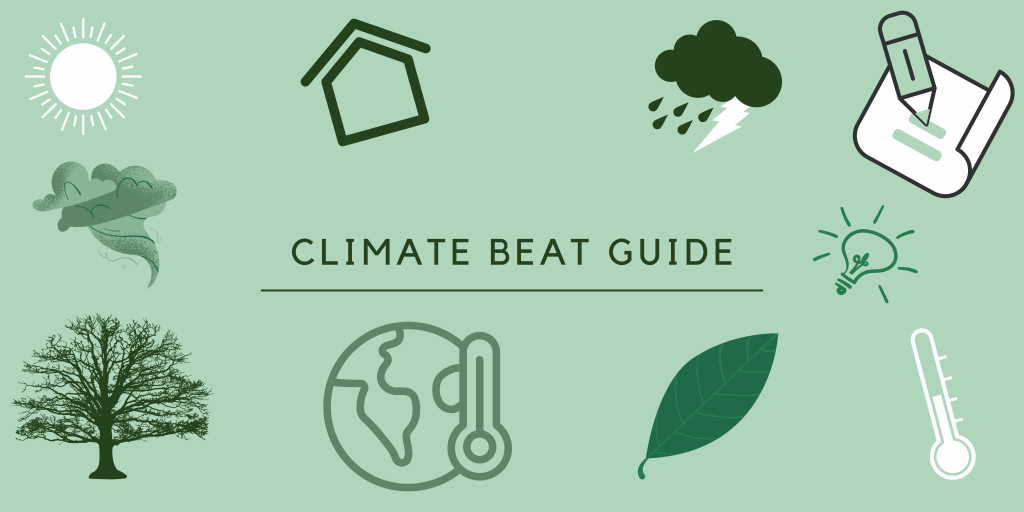
Why Cover Climate?
- Climate change affects many aspects of society, such as human health, agriculture and food security, water supply, transportation, energy and ecosystems.
- These aspects are expected to become increasingly disruptive as the century continues.
- As global temperatures and sea levels rise and as the oceans acidify, research shows that people living in poverty are the most severely impacted.
- Climate change affects everything from where a person can live to their access to health care, and it will be difficult for people in poverty to adjust.
- Up to 132 million people will be pushed into extreme poverty by 2030, according to research.
Research Guide
Here is a list of databases, essential reading and institutions with information to help you form the right questions about poverty and climate change.
Aren’t finding what you need? Check out our list of essential studies, data and tools.
If you’re feeling stuck, use the resources below to help answer these questions. They might help you get started on a story or expand on an idea about climate change and poverty.
- What percentage of families in your county live below the poverty line?
- What is the unemployment rate?
- What is the poverty rate in your county?
- Is extreme heat affecting my city’s poorest communities?
- What questions should I ask government officials about how they’re combatting the effects of climate change?
- How could climate change affect people in poverty in my state?
- How could climate change affect people in poverty in the future?
Databases & Datasets
This resource by American Forests, a 501(c)(3) nonprofit conservation organization, provides a map of tree cover in cities and towns across America. The Tree Equity Score calculates a score from 1-100 based on how much tree canopy and surface align with income, employment, race, age and health factors in the U.S. This resource provides a score for 150,000 neighborhoods and 486 urbanized areas in America.
The Annual Greenhouse Gas Index, produced by the U.S. Global Change Research Program, measures the capacity of Earth’s atmosphere to trap heat as a result of the presence of long-lived greenhouse gases. This data provides information about how human activity has affected the climate system.
Greenhouse Gas Reporting Program
The U.S. Environmental Protection Agency’s Greenhouse Gas Reporting Program (GHGRP) collects Greenhouse Gas (GHG) data from large emitting facilities, suppliers of fossil fuels and industrial gases that result in GHG emissions when used, and facilities that inject carbon dioxide underground.
American Community Service Data
This data from the U.S. Census Bureau provides detailed information about the U.S. population, including housing, economics, and demographic information. This data set will be useful in stories which examine climate issues in certain communities and neighborhoods.
Essential Reading & Viewing
Global Citizen: Why Climate Change and Poverty Are Inextricably Linked
This article explains the relation between poverty and climate change, and the implications climate change could have in the future.
NPR: As Rising Heat Bakes U.S. Cities, The Poor Often Feel It Most
This investigation from NPR and the University of Maryland’s Howard Center for Investigative Journalism uses NASA/U.S. Geological Survey satellite imagery and U.S. Census American Community Survey data to show the link between heat and income in U.S. cities. They detail their methodology and share the link to their open-source computer program for journalists and organizations who want to replicate their investigation.
Public Integrity and Columbia Journalism Investigations: Dangerous Heat, Unequal Consequences: How two neighborhoods in Arizona and Florida became hotspots for sickening heat
This project examines how low income communities experience higher rates of heat-related illnesses. The data used in this story shows that emergency room visits and hospitalizations due to heat-related illnesses are more likely in area with less income, and in neighborhoods with a history of racial segregation. The story links to a detailed data and methodology document to demonstrate how this investigation was possible.
Vox: How America’s hottest city is trying to cool down
This video visits Phoenix and explores how trees might save the city from extreme heat.
Academic Papers and Relevant Studies
NASA Landsat Science: Ecosystem, Vegetation Affect Intensity of Urban Heat Island Effect
This NASA report the origins and development of the “heat island” concept. The “heat island” effect was discovered when scientists first observed cities growing warmer than surrounding rural areas.
Sustainable and Resilient Infrastructure Journal: Urban Heat Implications from Parking, Roads, and Cars: a Case Study of Metro Phoenix
This research examines the infrastructure that contributes to Phoenix’s stifling heat. Other articles from Sustainable and Resilient Infrastructure focus on the sustainable development of resilient communities.
Institutions
U.S. Global Change Research Program
This federal program researches the forces shaping the global environment and their impacts on society. There you can access the National Climate Assessment, view reports, examine the physical science behind climate change and more.
The Environmental Protection Agency (EPA)
The EPA’s climate change website provides climate change facts, information about what the EPA is doing, and datasets and reports such as the Social Vulnerability Report which examines how climate change specifically impacts socially vulnerable populations based on income, education, race and ethnicity.
This page from the UN offers information on the intersection of environmental issues and biosafety, gender, conflict and disaster, sports and more.
Kyra Posey is a graduate student studying journalism at the University of Georgia.

